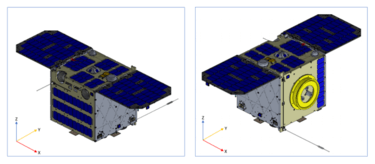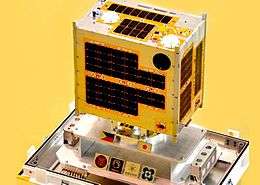Diwata-2
Diwata-2 or Diwata-2B[1] is a Philippine microsatellite launched in October 29, 2018.[2][3][4][5] It is the second satellite of the Philippine Scientific Earth Observation Microsatellite (PHL-Microsat) program after Diwata-1.
 | |
| Mission type | Communications / Earth Observation |
|---|---|
| COSPAR ID | 2018-084H |
| SATCAT no. | 43678 |
| Spacecraft properties | |
| Manufacturer | DOST University of the Philippines Hokkaido University Tohoku University |
| BOL mass | 56 kg (123 lb) |
| Start of mission | |
| Launch date | 04:51, October 29, 2018 (UTC) |
| Rocket | H-IIA |
| Launch site | Tanegashima LA-Y |
| Contractor | Mitsubishi Heavy Industries |
| Orbital parameters | |
| Reference system | Sun-synchronous orbit |
| Regime | Low Earth |
| Instruments | |
| High Precision Telescope (HPT) Space-borne Multispectral Imager (SMI) (with Liquid Crystal Tunable Filter (LCTF)) Enhanced Resolution Cameras Amateur Radio | |
Development
The satellite was developed by 11 scholars under the Philippine Department of Science and Technology (DOST), in cooperation with the Tohoku University and Hokkaido University in contrast to 9 DOST scholars who worked with Diwata-1, Diwata-2's predecessor.[6]
Unlike its predecessor, Diwata-2 takes advantage of radio communication technology by carrying an amateur radio payload for disaster relief purposes.[6] The satellite also hosts all embedded features of its predecessor.[7]
The planning phase of the Diwata-2's development includes a simulation model, a mechanical test model, an engineering model and a flight model. This stage ended with the flight model which was completed on August 29, 2018 and was handed over to the Japan Aerospace Exploration Agency (JAXA) on the following day.[8]
Instruments
Weighing 56 kg (123 lb),[1] Diwata-2 hosts an amateur radio payload which will enable people in the Philippines to relay messages through ham radio to any part of the country. This function is meant for disaster relief operations. The satellite will also carry Spaceborne Multispectral Imager (SMI) with liquid crystal tunable filter (LCTF) for environmental monitoring, and a high precision telescope (HPT) for rapid post-disaster assessment. Compared to Diwata-1 which hosted wide and middle field cameras, Diwata-2 will host enhanced resolution cameras.[6] The SMI, is equipped with an upgraded enhanced spatial resolution camera allowing the satellite to produced sharper images than the Diwata-1. It will also have a deployable solar panels to power the satellite's payloads.[9]
Launch and mission
The satellite was targeted by the DOST to be deployed as early as the second quarter of 2018.[10] The projected launch date was later adjusted at least twice; June 2018[11] and later pushed forward to fourth quarter of 2018.[12]
It was announced that on October 26, 2018 the satellite would be launched to space via the H-IIA from Japan[13] at the Tanegashima Space Center at around 13:08 and 13:20 (JST).[9] Unlike Diwata-1, Diwata-2 will be directly deployed from the rocket that will carry it from space and not from the International Space Station like its predecessor.[11][13] The satellite, which piggybacked on the bigger Japanese satellite Gosat-2 will be propelled to an elevation of 620 km (390 mi) above sea level.[9]
On October 29, 2018, the satellite was launched directly into orbit at 13:51 (UTC+9).[14] Communication between the satellite and the DOST-ASTI's ground station in Quezon City was first established on October 29 at 21:52 (UTC+8).[15]
Diwata-2 will have the same mission as its predecessor, Diwata-1. It has a sun-synchronous orbit[10] having been equipped with an experimental sun sensor which would allow the operators to determine the position of the satellite in respective to the sun and it will orbit at an altitude of 620 km (390 mi) above sea level. It will also have a fixed visit interval time unlike its predecessor, meaning it will hover above the same position on Earth for every 16 days. The satellite has a projected life expectancy of five years.[9]
Diwata-2 carries an amateur radio payload and was designated as PO-101 by AMSAT.[16] It is designated with the amateur call sign DW4TA by the National Telecommunications Commission of the Philippines.[17]
See also
- Agila-2
- Space program of the Philippines
References
- "Live coverage: Japan's H-2A rocket poised for 40th flight". SpaceFlight Now. October 28, 2018. Retrieved October 29, 2018.
- "Diwata-2 microsatellite scheduled for October 29 launch". FlipScience. October 28, 2018. Retrieved October 29, 2018.
- Cabalza, Dexter. "PH successfully sends Diwata-2 microsatellite into space". Philippine Daily Inquirer. Retrieved October 29, 2018.
- "PH-made microsatellite Diwata-2 flies into space". Rappler. Retrieved October 29, 2018.
- "DOST TO LAUNCH DIWATA-2 MICRO SATELLITE ON OCT. 29". League Online News. Retrieved November 6, 2018.
- Mondonedo-Ynot, Laureen (January 18, 2017). "Diwata 2's payload includes amateur radio". Sun Star Manila. Retrieved January 25, 2017.
- Sambalud, Mark (December 7, 2016). "Change is coming (1/2): How space technology is changing disaster risk management in PHL". Davao Today. Retrieved January 25, 2017.
- "Diwata-2 microsatellite launching on Oct. 29". BusinessMirror. October 28, 2018. Retrieved October 28, 2018.
- Tumampos, Stephanie; Resurreccion, Lyn (October 29, 2018). "PHL flying high–into space". BusinessMirror. Retrieved October 29, 2018.
- Usman, Edd (June 5, 2017). "How Diwata-2 is better than PH's first satellite, Diwata-1". Rappler. Retrieved June 6, 2017.
- Yee, Jovic (February 19, 2018). "Pinoy students fail to reach astronauts at space station". Philippine Daily Inquirer. Retrieved June 2, 2018.
- Reyes, Rizal Raoul (September 23, 2018). "Russia's elite space program opens doors to Filipino scholar". BusinessMirror. Retrieved October 15, 2018.
Diwata 2 is expected to be launched in the last quarter of this year.
- "DOST to launch microsatellite to gather data on disasters". PTV News. October 27, 2018. Retrieved October 27, 2018.
- Panela, Shaira (October 29, 2018). "PH-made microsatellite Diwata-2 flies into space". Rappler. Retrieved October 29, 2018.
- Resurreccion, Lyn (November 1, 2018). "Diwata-2 makes first contact with receiving station in PHL". BusinessMirror. Retrieved November 2, 2018.
- "Diwata-2 Designated Philippines-OSCAR 101 (PO-101)". AMSAT. April 11, 2019. Retrieved January 14, 2020.
- "PARA operators spearhead DIWATA2 testing". Philippine Amateur Radio Association. May 2019. Retrieved January 14, 2020.
.jpg)
